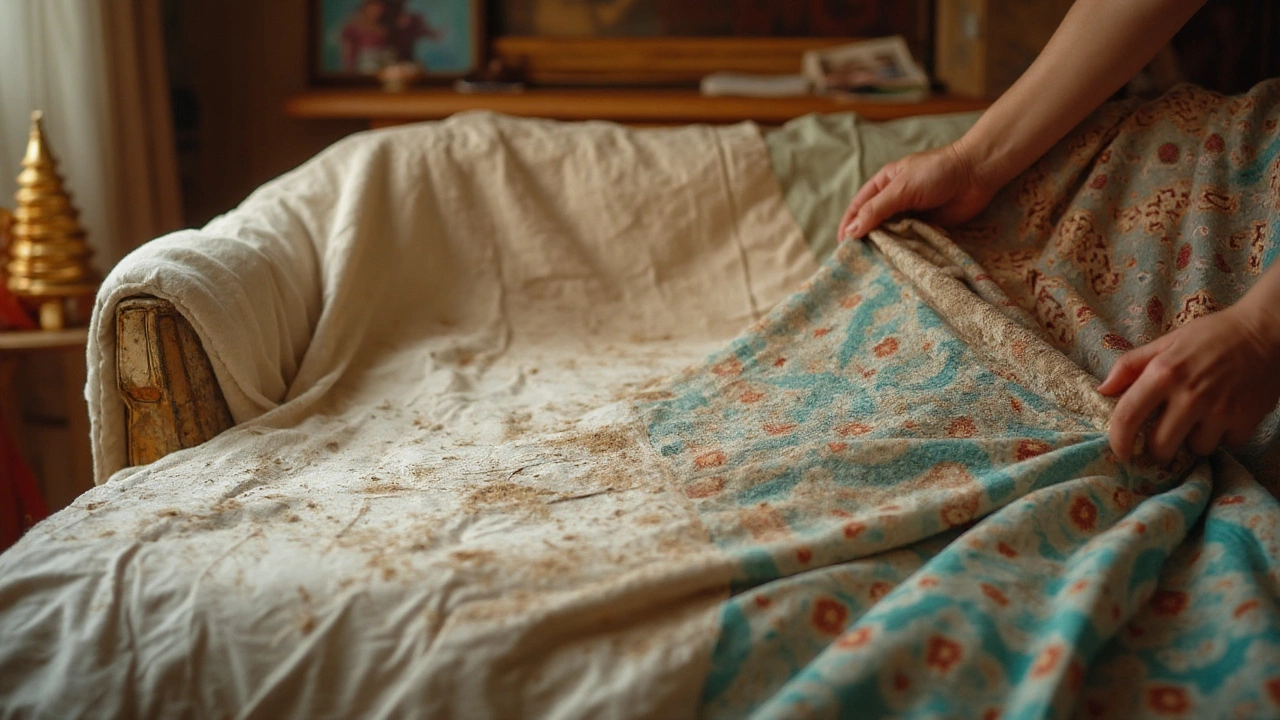Imagine walking into a friend’s place and spotting a floral flat sheet tucked around their nice leather sofa. You might wonder: Are they hiding a tragic stain? Maybe the cat’s been at it with her claws? Or are they secretly a fan of grandma chic? Whatever your first thought, one thing’s clear—throwing a sheet over a couch is way more common than most of us think. In Melbourne alone, you’ll spot it in stylish terrace houses, worn-down rentals, and even million-dollar mansions. There’s a bit of mystery (and a hell of a lot of practicality) in the humble habit of covering up the family sofa.
The Main Reasons People Toss a Sheet Over Their Couch
If you’re thinking covering up is just about hiding yesterday’s pizza sauce, you’d only be half right. Growing up, my granddad draped his favorite green sheet over the armchair every Sunday, and after chatting with dozens of Melbourne families, it turns out everyone has their own good reason. Here are the real, direct motives people do this—and some will probably hit home:
- Protection from pets and kids: If you live with a shedding golden retriever or a toddler with a marker collection, you get it. Covers catch fur, drool, and creative artwork long before your cushions take the hit. Surveys from cleaning services in Victoria show pet owners wash couch covers two to three times as often as other household textiles.
- Defending against spills and stains: Nobody’s immune to accidents. One dropped cup of coffee can turn a fancy white couch into a tie-dye disaster. That’s why more than 40% of couch owners aged 30-45 in local polls say they use removable sheets or blankets—mostly just-in-case.
- Beating allergens: For anyone in Melbourne who’s cursed with hay fever, sheets act as a filter, catching pollen and dust mites. Toss the cover in the wash and you kick most allergens to the curb.
- Easy cleaning: So much less effort than wrestling with the actual sofa fabric! A sheet you can ball up and toss in the machine is always going to win against hiring upholstery cleaners (which, by the way, charge an average of $130 per couch in our city).
- Preserving resale value: Cover up soft leather or expensive fabric and it’ll look newer for years. Facebook Marketplace sellers even mention “always covered” as a selling point to boost prices.
- Temperature control: Light cotton in summer and thick fleece in winter makes a surprising difference—fewer sticky backs in December and way less “cold shock” in the early mornings.
- Quick style upgrade: Renters (and commitment-phobes) love this. You’re not stuck with that orange ‘70s pattern forever—a crisp sheet hides ugliness, updates the look, or adds coziness, no renovations required.
- Cheap privacy screen: Got nosy neighbors peering into your living room? A draped couch changes the visual lines and blocks sneak peeks.
- Nostalgia or tradition: Some habits just stick—my aunt still covers her couch because her mum did, and hers before that. It’s almost comforting somehow.
The reasons are as varied as households themselves, but they all come down to protecting, refreshing, or personalising the most used seat in the house. Want to see just how popular this is? Check out the breakdown of cleaning habits from a recent survey in the table below.
| Household Type | Regular Couch Cover Usage | Weekly Washes (Median) |
|---|---|---|
| Families with young kids | 67% | 2 |
| Pet owners | 78% | 3 |
| Allergic adults | 53% | 2 |
| Singles w/out pets | 22% | 1 |
| Retirees | 44% | 1 |
It’s not just for mess—there’s a bit of clever living at play here, too. And while it might seem a bit old-school, it’s catching on with younger folks again, especially those sharing houses or moving a lot.

Couch Covers: Myths, Materials, and Mistakes to Avoid
Years ago, the idea of a sheet over the sofa screamed “student housing” or “grandma’s plastic-covered lounge.” These days, though, it’s getting a stylish refresh. Step into any homewares store on Chapel Street and you’ll see tailored covers in every shade and fabric. But before you grab the nearest throw, there’s more to it than just tossing a bedsheet and calling it a day.
First up, there are some funny myths out there. One is that couch covers only work for ancient hand-me-down sofas—that’s not true. Even brand new sofas benefit from that *extra* bit of protection, especially if you want them to last past your next lease. And let’s clear this up: those fitted ‘slipcovers’ are not the same as a regular flat sheet. Real slipcovers hug every curve and usually cost a bit more, but a smartly draped king-size sheet does 90% of the same job for a fraction of the price.
The next thing to think about is material. Not all sheets are equal. Here’s the lowdown, from a few years of spills and washes:
- Cotton: Breathable, easy to wash, good for most seasons. Go for thicker weaves to avoid tears.
- Microfibre: Lightweight but can be slippy (especially on leather couches). Stain-resistant, so great for heavy spill zones.
- Fleece or wool: Perfect for chilly Melbourne winters, but dust magnets and a little hard to keep looking sharp.
- Linen: Feels fancy, drapes nicely, but wrinkles easily—some people don't mind the casual look.
- Polyester blends: Tough as nails, but can trap warmth more than cotton. Still, nearly indestructible if you’ve got destructive little humans or pets.
Steer clear of sheets that are see-through, super silky, or too stiff—they won’t stay put or hide the old coffee marks. For anyone with allergies, wash the cover weekly in hot water at least 60°C. That kills dust mites better than anything else, as confirmed by recent Australian Research Council reports on household allergens.
Let’s talk mistakes. I’ve learned this the hard way:
- Don’t use anything that sheds lint, or you’ll end up vacuuming more than before.
- Make sure the sheet is big enough to tuck in—if it’s too small, it’ll slide everywhere and drive you mad. For a standard three-seater, a king flat sheet gives you loads to work with.
- If your couch is leather, avoid plastic-backed covers—they trap moisture and make you sweat; use pure cotton or linen for breathability.
- Wash new covers before first use: factory chemicals can sit on the fabric, causing skin irritation or just a nasty smell.
Think you need to spend a fortune? Nope. Most local op-shops in Melbourne sell stacks of patterned and plain sheets for under $10. Or, if you want a ‘custom’ vibe, you can cut an oversize blanket to shape—just hem the edges for a crisp finish.
Here’s a quick style tip most people never mention: layer up. Use a soft neutral sheet as the base, then add a textured throw for accent (bonus: the throw can hide any straight-from-the-clothesline wrinkles). Change these up with the seasons or as your taste shifts—no commitment, just fresh vibes year-round.

Practical Tips for Making the Most of Your Couch Cover
You want easy maintenance, a sharp look, and a rock-solid defense against daily chaos. It’s not hard, but there is a knack to it. After experimenting with dozens of combos and dealing with everything from muddy football boots to sneaky cat claws, here are steps and tips to keep your setup tight.
- Choose the right sheet or throw. Match the size to your sofa—a king or super-king sheet for a big three-seater, queen for a compact settee. Stretch it over the cushions, tucking deep into creases so it won’t budge when someone flops down.
- Secure the edges. If you don’t want to tuck constantly, invest in upholstery pins (sold online for about $7 a set) or use safety pins where they’re hidden. Some folks even use no-slip rug pads underneath for extra grip—just trim to fit.
- Shake out and wash regularly. Take it outside each week and give it a good shake to get rid of crumbs, fur, and dust. Hot washes (at least 60°C) work against stains and allergies—tough stains vanish with a bit of dish soap and a cold soak first.
- Change with the seasons. Breathable linen or light cotton feels best when it heats up, but in winter, swap in a heavier throw. Dark colours hide dirt better if you’re not a fan of laundry days, but lighter shades make small rooms look bigger and brighter.
- Style to match your mood. Layer multiple sheets or throws for depth (or emergency hiding power when Aunt Jean announces a surprise visit). Bold patterns can draw the eye away from worn-out arms, while subtle tones add calm to a crowded space.
- Use pillows strategically. Not only do they fluff up a covered sofa, but a few well-placed cushions can anchor the sheet, keeping it from slipping and making everything look intentional.
Worried about fashion points? Don’t sweat it—magazines like Inside Out and Real Living have run stories featuring living rooms with casually draped sheets and layered textiles called the ‘Australian cozy look.’ Turns out, it’s not just about function but also that informal, homey vibe people actually want to come home to.
Look, sofas are investment pieces. A decent new lounge in Australia now sets you back anywhere from $1,700 to $4,500, and kids, pets, or even too many happy hours can age them fast. That’s where the humble sheet comes in, stretching that investment for years. Not to mention, if you’re ever forced by a landlord to give back an undamaged sofa—or just want to sell at the highest price—a well-kept lounge under a simple cover can make all the difference.
Still think it looks daggy to throw a sheet over your couch? Maybe. But practicality beats perfection, especially when you’ve got a busy life and want to kick back without worrying about the odd spill or paw print. Next time you walk into a friend’s place and spot a well-covered sofa, you’ll know—there’s a method (and a lot of clever thinking) to the madness.

